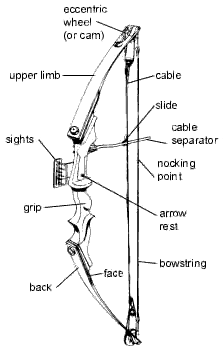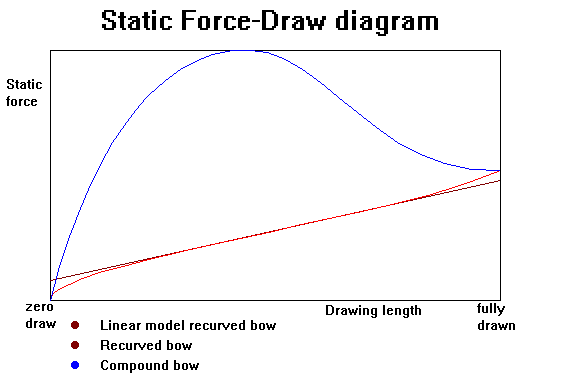The Compound Bow

(image credit to:
http://homestudy.ihea.com/advanced/images/compound_illus.gif)
A compound bow is a bow that uses a series of
levers and cables, primarily cams anc pulles to draw the bow. The
limbs of a ccompound bow are usually stiffer than that of a recurve or
longbow. The limbs are usually made from composite materials
which makes the bow more efficient than other bows, however the
stiffness of the limbs makes the bow unable to be drawn comfortably
with a string attached directly to them. The limbs store all of
the energy in the bow, no energy is stored in the cams or cables.
The string of a compound bow is connected to pulleys, which have more
cable attached to the opposite limb. When the bow is drawn the
string makes the pulley turn which causes the pulleys to pull the
cables which causes the limbs to bend and store energy.
The beauty of a compound bow is that the archer can draw a bow with a lot more stiffness in the limbs which will lead to more energy stored in the limbs. Usually the energy the archer can store in the limbs is limited by the force that the archer can handle when the string is fully drawn. The draw-force relationship accounts for the difference in energy storage. Most compound bows have a let-off of about 50%. Which means that when the bow is fully drawn the weight felt by the archer on the string will be half of what is was when the bow was in mid-draw. This can be modeled by a static force-draw diagram.

The beauty of a compound bow is that the archer can draw a bow with a lot more stiffness in the limbs which will lead to more energy stored in the limbs. Usually the energy the archer can store in the limbs is limited by the force that the archer can handle when the string is fully drawn. The draw-force relationship accounts for the difference in energy storage. Most compound bows have a let-off of about 50%. Which means that when the bow is fully drawn the weight felt by the archer on the string will be half of what is was when the bow was in mid-draw. This can be modeled by a static force-draw diagram.

(image credit to:
http://www.student.utwente.nl/~sagi/artikel/bas/archghh.html)
Home